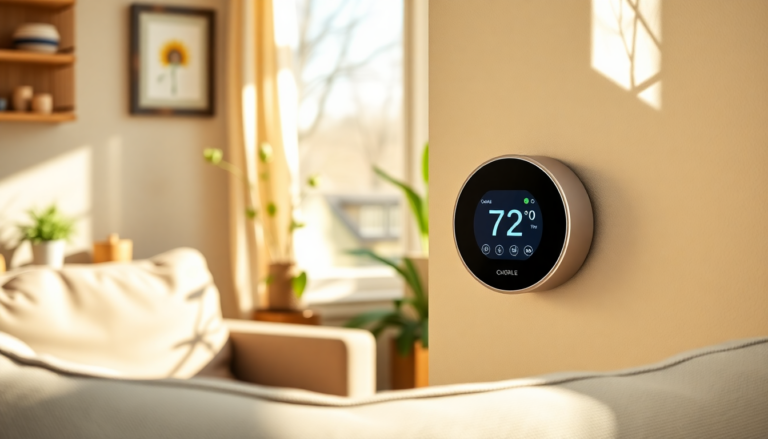Argomenti trattati
The chilly mornings of central Oregon remind us that cozy home temperatures are a must, especially during unpredictable seasons. As I reach for my smart thermostat, I realize just how transformative this technology can be—not only for comfort but also for energy savings. With the rising costs of energy and the increasing need for efficiency, smart thermostats are stepping into the spotlight, offering solutions that blend convenience with savings.
Understanding smart thermostats
Smart thermostats are more than just digital replacements for traditional models. At their core, they utilize advanced algorithms and wireless sensors to learn your habits and adjust temperatures accordingly. Imagine a device that adapts to your routine, ensuring your home remains comfortable when you’re there and conserving energy when you’re not. These systems can be controlled via smartphone apps, allowing for effortless management from anywhere, whether you’re at work or on vacation.
Take, for instance, the Nest Learning Thermostat. It features a sleek design and intuitive interface, displaying your settings on a vibrant touchscreen. Adjustments can be made effortlessly with a simple swipe or voice command, providing both tactile and digital control. Moreover, the integration of satellite sensors enables the thermostat to monitor temperatures in various rooms, ensuring that comfort isn’t confined to just one area of your home.
The financial benefits of smart thermostats
The rising cost of energy is a pressing concern for many households. According to a recent CNET survey, a significant percentage of Americans are worried about their energy bills, especially as heating costs have surged in recent winters. Smart thermostats present a viable solution, with potential savings ranging from 8% to 26% on annual heating and cooling expenses.
By learning your schedule and adjusting accordingly, these devices help reduce unnecessary heating or cooling when no one is home. Features like eco mode activate energy-saving settings, further contributing to reduced bills. Users have reported savings of approximately $131 to $250 annually, making these devices not just a luxury but a smart financial decision.
Installation and ease of use
One of the most appealing aspects of smart thermostats is their relatively simple installation process. Most models can be installed without professional help, provided you have a basic understanding of your home’s wiring system. However, if you’re unsure, it’s always a good idea to consult an electrician. Once installed, the setup is straightforward, with guided instructions available through the accompanying app.
For renters, smart thermostats can still be beneficial. They offer significant energy savings without the need for extensive renovations. However, it’s crucial to check lease agreements before installation, as permission from landlords may be required. For landlords, these devices are an attractive option to maintain energy efficiency across properties while keeping costs in check.
Advanced features of smart thermostats
The innovation in smart thermostats goes beyond just temperature control. Many models now include features such as presence sensing, which detects when individuals are in the home and adjusts settings accordingly. This eliminates the need for constant manual adjustments and ensures that energy is used efficiently, only when necessary.
Moreover, satellite sensors can be placed in areas where people spend the most time, sending accurate temperature readings back to the main unit. This ensures that comfort is prioritized in those spaces, rather than relying solely on where the thermostat is located. For example, if your main thermostat is in a hallway, but everyone congregates in the living room, the satellite sensor can adjust the temperature based on that activity.
Environmental impact and future potential
Sustainability is a growing concern for many homeowners, and smart thermostats contribute to reducing overall energy consumption. By optimizing heating and cooling efforts, these devices help lower carbon footprints while also saving money. As technology advances, we can expect even more innovative features that promote energy efficiency and environmental responsibility.
In addition to energy savings, smart thermostats can work in tandem with other eco-friendly technologies, such as heat pumps and solar panels, to create a comprehensive energy-efficient home. As these systems become more integrated, the potential for significant reductions in energy costs and environmental impact will continue to expand.
Privacy considerations
As with any smart technology, privacy is a valid concern. Smart thermostats do collect data to enhance user experience, but it’s essential to understand what information is gathered. Most manufacturers prioritize user privacy and provide options to limit data sharing. Utilizing secure Wi-Fi networks and enabling two-factor authentication can further safeguard your information.
Ultimately, the benefits of smart thermostats far outweigh potential privacy concerns. They represent a significant advancement in home technology, offering comfort, convenience, and cost savings.
Final thoughts on smart thermostat adoption
Adopting a smart thermostat is a step toward modernizing your home and enhancing energy efficiency. With options available to suit various budgets and preferences, these devices are becoming increasingly accessible. Whether you’re a tech enthusiast or simply looking for ways to save on energy bills, a smart thermostat is a worthwhile investment that will pay dividends over time.
As we navigate the complexities of climate change and rising energy costs, smart thermostats present a practical solution for homeowners seeking comfort and efficiency. Embracing this technology paves the way for a more sustainable future, making it easier than ever to maintain a cozy home while being mindful of our planet.

